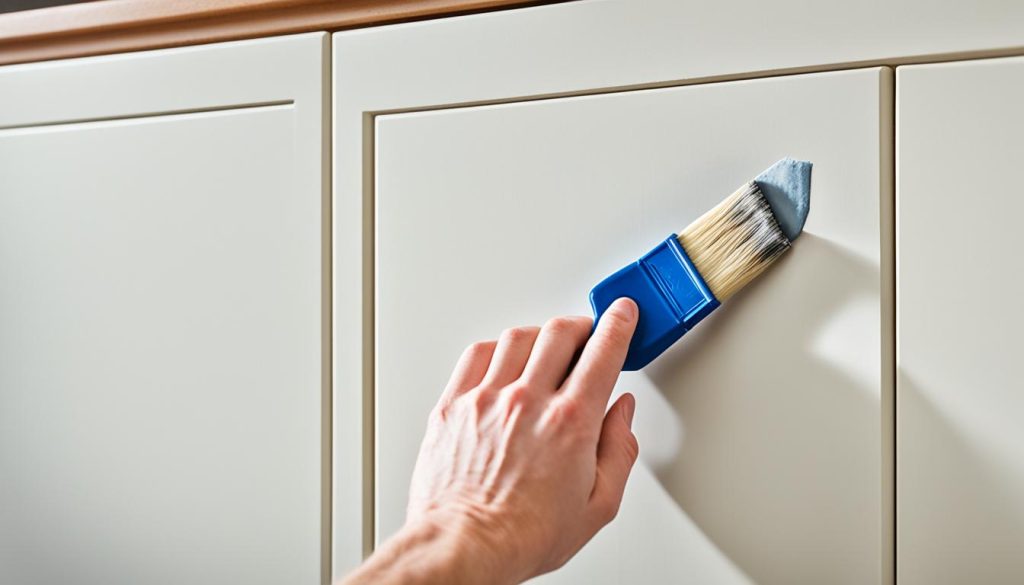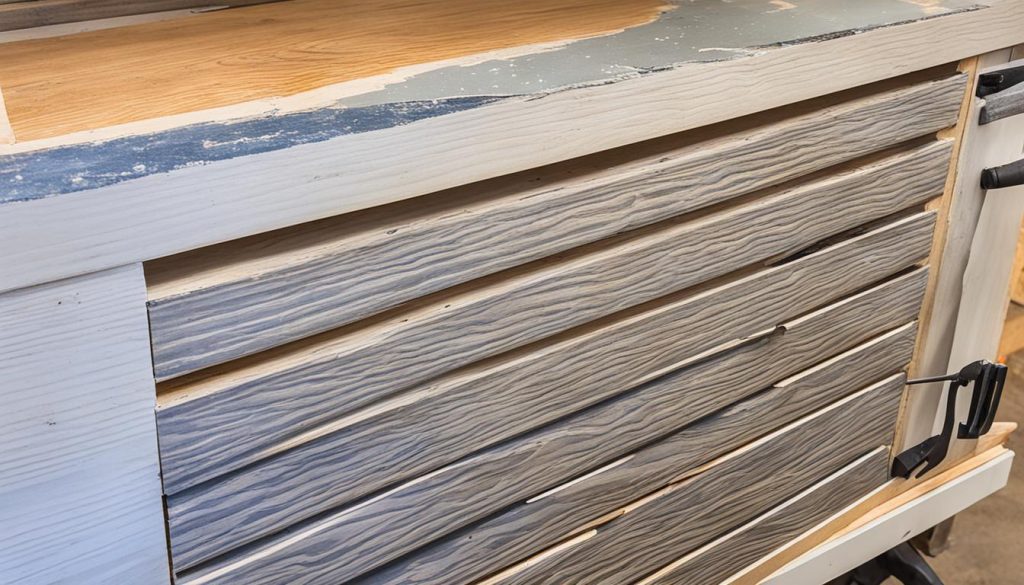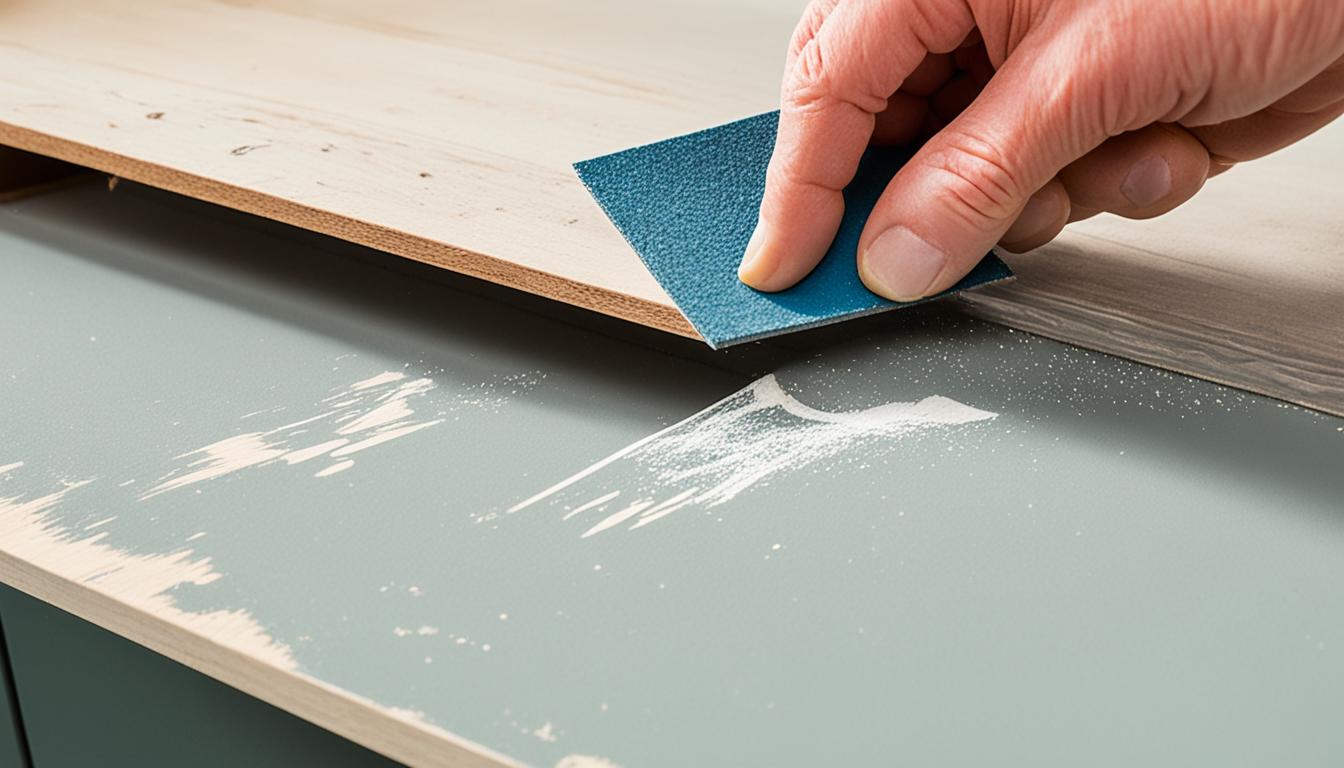If you’re frustrated with the peeling paint on your kitchen cabinets, you’re not alone. Did you know that paint peeling is a common issue that affects countless homeowners?
Peeling paint on kitchen cabinets can make your kitchen look worn and dated. It can be caused by various factors, such as exposure to moisture, heat from appliances, general wear and tear, inferior prep work, and the use of cheap paint.
In this article, I’ll provide you with a quick guide on how to fix paint peeling off cabinets. Whether you want to touch up minor peeling or undergo a complete refinishing, I’ll walk you through the steps. Plus, I’ll explain the benefits of hiring a professional cabinet refinishing company to ensure a flawless result.
Key Takeaways:
- Paint peeling off cabinets is a common issue that can make your kitchen look outdated.
- Causes of paint peeling include exposure to moisture, heat from appliances, and general wear and tear.
- If the peeling is minimal, you can try a touch-up by sanding, cleaning, spot priming, and applying touch-up paint.
- If the peeling is extensive, a complete refinishing may be necessary, involving paint removal, preparation, and application of new paint or stain.
- Hiring a professional cabinet refinishing company saves time and effort, ensures a high-quality result, and allows for customization.
Common Causes of Paint Peeling on Kitchen Cabinets
The paint on kitchen cabinets can peel due to several reasons. One common cause is exposure to moisture, which can cause the wood underneath the paint to swell and the paint to bubble and peel. Heat from appliances like ovens and dishwashers can also dry out and crack the paint over time. General wear and tear from daily use, especially on cabinet doors and drawers, can contribute to peeling. Additionally, improper prep work, such as inadequate cleaning, sanding, and priming before painting, can lead to poor paint adhesion. Finally, the use of low-quality paint can make cabinets more prone to chipping and peeling.
| Possible Causes of Paint Peeling | Effects on Kitchen Cabinets |
|---|---|
| Exposure to moisture | Wood swelling, paint bubbling and peeling |
| Heat from appliances | Paint drying out, cracking and peeling |
| General wear and tear | Peeling on cabinet doors and drawers |
| Improper prep work | Poor paint adhesion |
| Use of low-quality paint | Increased chipping and peeling |
How to Touch Up Peeling Kitchen Cabinets
If the paint on your kitchen cabinets is peeling off in small areas, you can easily touch it up to restore their appearance. Here’s a step-by-step guide on how to do it:
- Start by lightly sanding the peeled areas to feather the edges and roughen the surface. This will help the new paint adhere better.
- Clean the sanded areas thoroughly to remove any residue. Use a mild detergent and water solution to wipe away any dirt or grease.
- If there is any exposed wood after sanding, spot prime those areas to ensure proper adhesion of the new paint.
- Choose a touch-up paint that matches the color of your cabinets. It’s best to use the same type of paint that was originally applied.
- Apply the touch-up paint in thin coats, using a small brush or a foam applicator. Start from the center of the peeled area and work your way outwards.
- Allow each coat to dry completely before applying the next one. This will ensure a smooth and seamless finish.
- Continue applying additional coats of touch-up paint until the peeled area is fully covered and blends in with the rest of the cabinet.
Note that this touch-up method is most effective for small chips and cracks in the paint. If the peeling is extensive or covers large areas, a complete refinishing may be necessary to achieve a seamless and long-lasting result.
Example:

Here’s an example of how touch-up paint can be used to hide peeling in kitchen cabinets. The before-and-after image demonstrates how this DIY technique can significantly improve the appearance of your cabinets, making them look refreshed and well-maintained.
Complete Refinishing of Peeling Kitchen Cabinets
If the peeling on your kitchen cabinets is extensive, a complete refinishing may be necessary. This process involves removing all of the old paint, properly preparing the cabinets, and applying new paint or stain.
To refinish your cabinets, you can hire a professional cabinet refinishing company. They will use chemical strippers or sanders to remove the old paint, ensuring a smooth and even surface for the new finish. The cabinets will be thoroughly cleaned, patched, and sanded before the new paint or stain is applied.
Professional refinishing can give your cabinets a fresh and updated look without the need for expensive replacement.

Benefits of Professional Cabinet Refinishing
Hiring a professional cabinet refinishing company has several advantages when it comes to transforming your kitchen cabinets. Firstly, it saves you valuable time and effort. Instead of tackling the refinishing process yourself, the experts will handle all the necessary steps, from removing the old paint to preparing the cabinets for a flawless new finish. Their knowledge and experience ensure that the job will be done efficiently and effectively.
Another significant benefit of professional refinishing is the high-quality result you can expect. With their expertise, professionals can achieve even coverage and a durable finish, enhancing the overall appearance and longevity of your cabinets. Moreover, refinishing your existing cabinets is a cost-effective alternative to replacing them entirely. By investing in professional refinishing, you can completely revive the look of your kitchen without breaking the bank.
When you hire a cabinet refinishing company, you also have the advantage of customization. Professionals allow you to choose a custom color and finish that suits your personal style and preferences, ensuring that your cabinets reflect your unique taste. Whether you prefer a classic, modern, or eclectic look, the professionals will be able to bring your vision to life with their skills and expertise.
